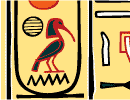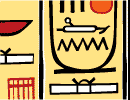|
The Book of the Dead
A preserved body, amulets, a funeral mask, a decorated coffin or even a
sarcophagus, a tomb full of goodies, and a bunch of shabtis-- isn't that enough
to guarantee that the parts of the soul will live forever in the afterlife? Not
quite. Another "must have" was a copy of the Book of the Dead.
It's called a book, but it's really a collection of spells and prayers
written on papyrus scrolls. Before the mummy's spirit could reach the afterlife,
it had to pass through a dangerous underworld known as Duat. Monsters, cobras,
and lakes of fire were some of the dangers found in Duat. Along with the amulets
wrapped up in the mummy and the spells painted on the coffin, the Book of the
Dead helped the spirit make it safely through this perilous trip.
The ultimate test for the spirit's voyage through Duat was the Weighing of
the Heart. This test, as illustrated in the Book of the Dead, shows the dead
person's ba anxiously awaiting the results. Anubis checks that the scale is
working properly, as the ibis-headed scribe god Thoth stands ready to record the
results. The heart of the dead person is weighed against "the feather of truth."
If the heart weighs less, the spirit is free to go on to meet Osiris in the
afterlife. But if the heart is heavy with sin, it is thrown to Ammit, "the
devourer of the dead," who gobbles it up, denying the spirit an afterlife and
causing it to cease to exist.
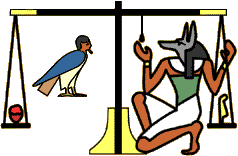 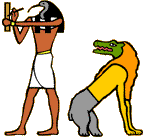
The funeral procession
Because most cemeteries were located on the west side of the Nile, a funeral
almost always involved crossing the river. The embalmers transported the mummy
across the river on a boat, where it was picked up by the mourners on the other
side. The mummy would be placed on a boat-shaped sled called a bier. The bier
was either pulled by oxen or it was just dragged by people. As the funeral
procession made its trip to the tomb, servants carried food and drink, shabtis,
the canopic jars, and the mummy's possessions. Several priests walked in the
procession too, reciting spells and prayers from the Book of the Dead.

The importance of a person was judged by how many mourners were present at
the funeral. Sometimes, families would hire women to mourn at the funeral. They
would wave their arms, throw dust in their hair, and weep. The better the
performance, the more they were paid!
Once the funeral procession arrived at the tomb, a ceremony called The
Opening of the Mouth was performed on the mummy. A priest would touch the
mummy's mouth with a special instrument that magically restored the mummy's
senses, allowing it to eat, drink, and enjoy its afterlife properly.
|
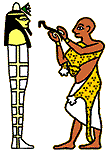 |
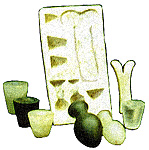
some of the tools used in the
Opening of
the Mouth ceremony |
Finally, the mummy was placed in its tomb with all its possessions. The
mourners would have a feast at the door of the tomb, and waste materials left
over from the mummification process would be buried nearby. The mummy, now safe
from decay and protected by spells and amulets, would hopefully soon join Osiris
in the afterlife!
|
